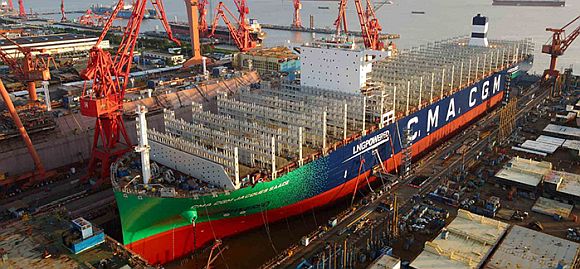 Last month, China’s Shanghai Jiangnan-Changxing Shipyard launched the CMA CGM Jacques Saadé, the first in a new fleet of nine French-flagged, 23,000-TEU, LNG-powered containerships that will join the group’s fleet in 2020 on the French Asia Line. Not only will the new ship be one of the world’s largest container ships when it goes into service, and it will also be the largest LNG powered container ship in the world. The ship will be powered by a Winterthur Gas & Diesel Ltd (WinGD) 12-cylinder X92DF dual-fuel low-speed engine, developing 63,840 kW (91,766 HP) at 80 rpm.
Last month, China’s Shanghai Jiangnan-Changxing Shipyard launched the CMA CGM Jacques Saadé, the first in a new fleet of nine French-flagged, 23,000-TEU, LNG-powered containerships that will join the group’s fleet in 2020 on the French Asia Line. Not only will the new ship be one of the world’s largest container ships when it goes into service, and it will also be the largest LNG powered container ship in the world. The ship will be powered by a Winterthur Gas & Diesel Ltd (WinGD) 12-cylinder X92DF dual-fuel low-speed engine, developing 63,840 kW (91,766 HP) at 80 rpm.
For nearly 700 years, fishermen have been trawling for shrimp from horseback in the small town of Oostduinkerke, on the Belgian coast. Whether the tradition is dying or enduring may be the subject of debate. It is, however, both singular and fascinating. Here is a short video that describes Belgian fishing on horseback.
 The North Korean handysize bulk carrier Wise Honest has been sold in a sealed bid auction. The proceeds of the auction will go to compensate the family of Otto Warmbier, the American student who died in 2017 shortly after being released in a vegetative state by North Korea after being tortured for allegedly trying to steal a propaganda poster, as well as the family of the Rev. Dong Shik Kim, who was kidnapped, tortured and executed by North Korean agents in 2000.
The North Korean handysize bulk carrier Wise Honest has been sold in a sealed bid auction. The proceeds of the auction will go to compensate the family of Otto Warmbier, the American student who died in 2017 shortly after being released in a vegetative state by North Korea after being tortured for allegedly trying to steal a propaganda poster, as well as the family of the Rev. Dong Shik Kim, who was kidnapped, tortured and executed by North Korean agents in 2000.
The 580-foot, 17,601-ton single-hull bulk carrier was seized in April 2018 by Indonesian authorities for violating international sanctions. The ship was taken over by the US in May of 2019 and was towed to American Samoa. In July, it was sold under the orders of federal judges in New York and Washington.
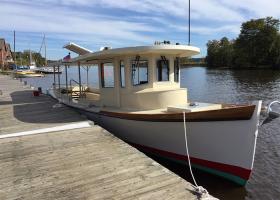
Solaris, docked at the Hudson River Maritime Museum in Kingston’s Rondout Basin
The Solaris, a solar-powered tour boat owned by the Hudson River Maritime Museum in Kingston, NY will provide trips across the Hudson River on Saturday and Sunday, October 19 and 20. (They also previously offered trips at the end of September.)
The Mid-Hudson News reports that the boat will run every hour, leaving the Newburgh Washington Street Boat Launch at 2 Washington Street. It will depart Beacon from the Beacon Institute Dock on the waterfront near the Metro-North Train Station, every half-hour. The crossing takes 20 minutes.
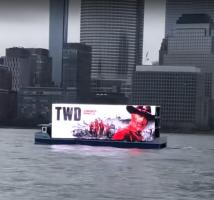 Roughly a year ago, a tug pulling a barge carrying a double-sided 60 foot long LED screen blasting animated, high-definition digital ads for everything from beer to movies, appeared on the Hudson and East Rivers, threatening to turn the riverscape into another neon Times Square. The company which operated the barge, Ballyhoo Media, proclaimed their barge “the future of digital billboard advertising.” Many New Yorkers considered it to be a nuisance and an eyesore.
Roughly a year ago, a tug pulling a barge carrying a double-sided 60 foot long LED screen blasting animated, high-definition digital ads for everything from beer to movies, appeared on the Hudson and East Rivers, threatening to turn the riverscape into another neon Times Square. The company which operated the barge, Ballyhoo Media, proclaimed their barge “the future of digital billboard advertising.” Many New Yorkers considered it to be a nuisance and an eyesore.
Since then there have been lawsuits and legislation to restrict the barge and the others like it. At the same time, the Ballyhoo CEO Adam Shapiro promised to fight back and indeed flout the actions taken against the floating advertizements.
For all the sturm und drang, the battle appears now to be over and the billboard barge has lost. Gothamist reports:
 Late season cruises have their own inherent risks. In the case of a recent cruise on the Norwegian Spirit these risks were compounded by the remnants of Hurricane Lorenzo, now a post-tropical storm, which was pounding the Atlantic Coast of Europe.
Late season cruises have their own inherent risks. In the case of a recent cruise on the Norwegian Spirit these risks were compounded by the remnants of Hurricane Lorenzo, now a post-tropical storm, which was pounding the Atlantic Coast of Europe.
The 2,016 passenger Norwegian Spirit left Southampton on September 27th, bound for a two-week cruise with nine port calls in the Netherlands, Norway, Iceland, and Ireland. It was billed as the “Mystical Fjords” cruise. For many of its passengers, it would become the “cruise from hell,” featuring missed port calls, spoiled food, and overflowing toilets. Before it was all over, the passengers were in a near mutiny and close to rioting
 One of the most interesting accounts of a sea serpent is that of the HMS Daedalus in 1848. When sailing in the South Atlantic, some 300 miles from the coast of present-day Namibia, officers and crew aboard the ship saw what they described as an enormous serpent swimming with its head four feet above the water and roughly another sixty feet of the creature extending back in the sea. Captain McQuahoe also said that “[The creature] passed rapidly, but so close under our lee quarter, that had it been a man of my acquaintance I should have easily have recognized his features with the naked eye.” According to seven members of the crew, it remained in view for around twenty minutes. Lt. E.A. Drummond recorded the events in his diary the day he observed them and also made sketches of what he saw.
One of the most interesting accounts of a sea serpent is that of the HMS Daedalus in 1848. When sailing in the South Atlantic, some 300 miles from the coast of present-day Namibia, officers and crew aboard the ship saw what they described as an enormous serpent swimming with its head four feet above the water and roughly another sixty feet of the creature extending back in the sea. Captain McQuahoe also said that “[The creature] passed rapidly, but so close under our lee quarter, that had it been a man of my acquaintance I should have easily have recognized his features with the naked eye.” According to seven members of the crew, it remained in view for around twenty minutes. Lt. E.A. Drummond recorded the events in his diary the day he observed them and also made sketches of what he saw.
What makes the sighting so unusual is the length of the observation, the number of witnesses and that several Royal Navy officers were among that number. Three professional drawings of the creature, based on the captain’s account, were later published. Sketches made by Lt. Drummond finally turned up in 1977.
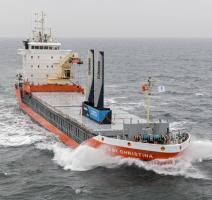 Econology is a word that has been floating around the internet recently. A combination of economy and ecology, it refers to technology that is good for the ecology, while at the same time making economic sense. The Dutch firm eConowind is seeking to apply econology to shipping. We recently posted about the upcoming installation of two of eConowind’s Ventfoils on the 3,600 DWT general cargo vessel Ankie, operated by Van Dam Shipping.
Econology is a word that has been floating around the internet recently. A combination of economy and ecology, it refers to technology that is good for the ecology, while at the same time making economic sense. The Dutch firm eConowind is seeking to apply econology to shipping. We recently posted about the upcoming installation of two of eConowind’s Ventfoils on the 3,600 DWT general cargo vessel Ankie, operated by Van Dam Shipping.
While the Ventfoils on the Ankie will be fixed, eCononsail also offers an innovative modular sail-assist product, which they developed by literally thinking inside the box.
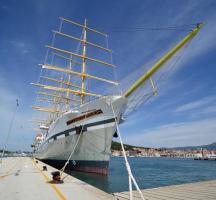 For the past several years, we have followed the construction of the newest and largest square-rigged luxury passenger cruise ship built for the Star Clipper cruise fleet — the Flying Clipper. Recently, the 300 passenger, five-masted bark has been seen on trials off Split. Unfortunately, the ship, built by the Croatian shipyard Brodosplit, is also sailing in limbo.
For the past several years, we have followed the construction of the newest and largest square-rigged luxury passenger cruise ship built for the Star Clipper cruise fleet — the Flying Clipper. Recently, the 300 passenger, five-masted bark has been seen on trials off Split. Unfortunately, the ship, built by the Croatian shipyard Brodosplit, is also sailing in limbo.
Total Croatia News reports that the 70 million euro contract between Brodosplit and Star Clippers owner Mikhail Krafft has recently been terminated because both sides claimed that it had been violated: Krafft had exceeded delivery deadlines for masts and rigging and the Split shipyard failed to meet the conditions for completion. The dispute is moving towards arbitration, but, according to unofficial information, negotiations over a possible compromise are also in progress.
In the meantime, the ship is sailing under the name Brodosplit 483. Brodosplit told Seatrade Cruise News it is no longer obliged to hand over the ship to the buyer and is free to dispose of the newbuilding adding ‘there is a great deal of interest in this unique vessel.’
 This week, as China looked back at 70 years of Communist rule, its military parade looked to the future with a whole new generation of deadly naval and airborne weaponry. Newsweek reports that in a speech last week, retired Admiral William McRaven, the former head of U.S. special forces, called China’s intensifying military build-up “a holy shit moment for the United States.”
This week, as China looked back at 70 years of Communist rule, its military parade looked to the future with a whole new generation of deadly naval and airborne weaponry. Newsweek reports that in a speech last week, retired Admiral William McRaven, the former head of U.S. special forces, called China’s intensifying military build-up “a holy shit moment for the United States.”
One of the new weapons on display for the first time was the Dongfeng-17 (DF-17), a hypersonic anti-ship missile, dubbed a “carrier killer.” Reportedly designed to operate at speeds of Mach 5 or greater and to be highly maneuverable in its glide stage, some analysts are concerned that the existing US anti-ballistic defense systems might not be able to counter the new missile.
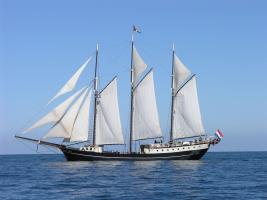
Photo: Lukas Riebling
Following the example of Greta Thunberg, who traveled to a UN climate conference by sail in August, 36 young climate change activists set sail from Amsterdam on October 2, bound for COP25 – the United Nations Climate Conference. Rather than boarding airplanes, the group chose to charter the Regina Maris, a 101 ft (31m) LOA, 1970 built steel Dutch topsail schooner for the 5,000 nautical mile trip.
Classic Sailor reports that the activists, from all across Europe, are hoping to use the seven-week voyage to brainstorm ideas for greener transport which they then intend to present to world governments meeting in Santiago from 2 – 13 December. But they will also be helping the six permanent crew to sail Regina Maris. Living in four-person cabins they plan to eat vegan meals. The voyage has scheduled stops at Casablanca, Tenerife, Cape Verde, and Recife to pick up fresh fruit and vegetables and get ashore for a few hours. When they arrive in Rio they will take a bus across the South American continent to Chile – a distance of some 3,000 kilometers.
Jeppe Bijker, one of four Dutch initiators of the Sail to the COP project, told reporters he did not expect people to give up flying altogether. “But we do ask that they think about why they are flying. You should ask yourself do you really need to go? Maybe it’s a business flight … and there could be an e-conference instead. And do you need to take so many short-haul trips?” Continue reading
North Korea appears to be aggressively developing the capacity to deploy a ballistic missile submarine even as it purports to continue to negotiate denuclearization with the current administration.
Yesterday, the Washington Post reported that North Korea successfully tested a new type of ballistic missile the previous day that is designed to be fired from a submarine, in a violation of U.N. Security Council resolutions, just ahead of a resumption of negotiations with the United States over its nuclear weapons program.
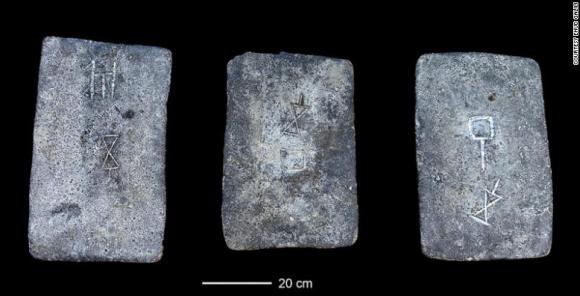
Tin ingots mined in Cornwall 1300 BCE
One open question about the Bronze Age in the Middle East was where the tin was sourced. Bronze is an alloy of primarily copper and tin. Recently, scientists identified the surprising source of tin ingots found in three shipwrecks off the coast of Isreal. Based on metallurgic data, they concluded that the tin most likely came from Cornwall and Devon in southwest England. The age of the shipwrecks suggests that it was mined around 1300 BCE. The discovery implies that Bronze Age maritime trade routes were longer and more complex than had previously been understood.
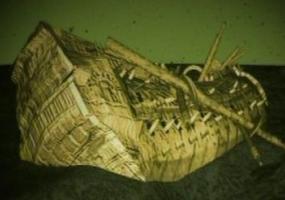 Civilian divers were on an archeological dive on the London, a Royal Navy ship built-in 1656 which exploded and sank in 1665 in the Thames Estuary. They were shocked to find a large World War II bomb in the wreck. And it wasn’t just any bomb. The BBC reports that it was a German parachute ground mine, at 987kg (2,175lbs) one of the biggest bombs used by the Luftwaffe during the war.
Civilian divers were on an archeological dive on the London, a Royal Navy ship built-in 1656 which exploded and sank in 1665 in the Thames Estuary. They were shocked to find a large World War II bomb in the wreck. And it wasn’t just any bomb. The BBC reports that it was a German parachute ground mine, at 987kg (2,175lbs) one of the biggest bombs used by the Luftwaffe during the war.
 Hurricane Lorenzo strengthened briefly to a Category 5 storm over the weekend, becoming the strongest hurricane on record so far north and east in the Atlantic Ocean. On Saturday, we posted about the sinking of the tug-supply vessel Bourbon Rhode in the hurricane. Eleven of the fourteen crew are missing and presumed dead. Three of the crew were rescued following the sinking.
Hurricane Lorenzo strengthened briefly to a Category 5 storm over the weekend, becoming the strongest hurricane on record so far north and east in the Atlantic Ocean. On Saturday, we posted about the sinking of the tug-supply vessel Bourbon Rhode in the hurricane. Eleven of the fourteen crew are missing and presumed dead. Three of the crew were rescued following the sinking.
Lorenzo is unusual in that it strengthened so dramatically while so far east. Most hurricanes strengthen after moving farther west and remaining in warmer southern waters. According to weather.com, Lorenzo is by far the farthest east in the Atlantic Ocean any of the previous 35 Category 5 hurricanes that have occurred in records dating to the 1920s.
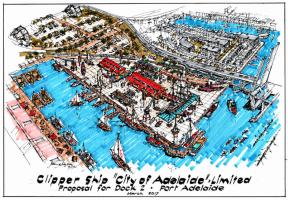 The world’s oldest clipper ship, City of Adelaide, may be one step closer to having a permanent home.
The world’s oldest clipper ship, City of Adelaide, may be one step closer to having a permanent home.
Last March we posted about how the clipper ship City of Adelaide was being kicked off Dock 1 in its namesake port city and was expected to be moved to Dock 2. Unfortunately, Dock 2 was described as a largely inaccessible, industrial wasteland. Promised improvements had not been made in preparation for moving the historic ship.
On Friday, on its Facebook page, it was announced that an agreement has been signed to make Dock 2 a permanent home with suitable infrastructure and access.
The clipper ship City of Adelaide was built in Sunderland, England, and launched on May 7, 1864.
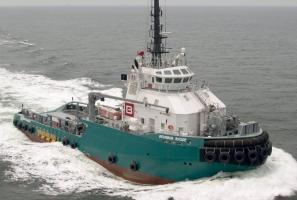 Three sailors have been rescued from a lifeboat following the sinking of the 164′ tug supply boat Bourbon Rhode in Hurricane Lorenzo. The remaining eleven crew members are missing.
Three sailors have been rescued from a lifeboat following the sinking of the 164′ tug supply boat Bourbon Rhode in Hurricane Lorenzo. The remaining eleven crew members are missing.
The tug had sent a distress signal on Thursday and a rescue effort was mounted by the French and US governments assisted by commercial ships. The tug’s owner confirmed in a press release on Saturday that the Bourbon Rhode had sunk.
In an upcoming PBS documentary, Octopus: Making Contact, a scientist observes an octopus changing color while sleeping upside down in a tank. Is it dreaming? Marine biologist Dr. David Scheel speculates what the dream might be in accordance with the particular shade of camouflage being exhibited at each moment.
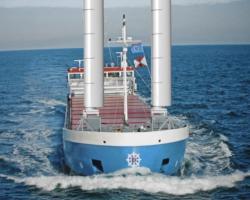 Van Dam Shipping, based in Spijk, Netherlands, has signed a contract for the installation of an eConowind propulsion system on its 3,600 DWT general cargo vessel Ankie. At first glance, two vertical structures in the graphic of the ship look like Flettner rotors. They are different, although a related technology. The two “sails” are a Ventifoil system, a development of Jacques Cousteau’s turbosail design which he used on the research vessel Alcyone in the mid-1980s.
Van Dam Shipping, based in Spijk, Netherlands, has signed a contract for the installation of an eConowind propulsion system on its 3,600 DWT general cargo vessel Ankie. At first glance, two vertical structures in the graphic of the ship look like Flettner rotors. They are different, although a related technology. The two “sails” are a Ventifoil system, a development of Jacques Cousteau’s turbosail design which he used on the research vessel Alcyone in the mid-1980s.
 A disturbing new report by the U.N. Intergovernmental Panel on Climate Change concludes that the rate at which the world’s oceans are heating up is accelerating and that sea levels are rising more quickly than previous predictions. The Special Report on the Ocean and Cryosphere in a Changing Climate notes that “the ocean is warmer, more acidic and less productive. Melting glaciers and ice sheets are causing sea level rise, and coastal extreme events are becoming more severe.”
A disturbing new report by the U.N. Intergovernmental Panel on Climate Change concludes that the rate at which the world’s oceans are heating up is accelerating and that sea levels are rising more quickly than previous predictions. The Special Report on the Ocean and Cryosphere in a Changing Climate notes that “the ocean is warmer, more acidic and less productive. Melting glaciers and ice sheets are causing sea level rise, and coastal extreme events are becoming more severe.”
NPR reports that the report is a synthesis of the most up-to-date climate science on oceans and ice, and it lays out a stark reality: Ocean surface temperatures have been warming steadily since 1970, and for the past 25 years or so, they’ve been warming twice as fast.
